Intro
There are more mountain bike tires on the market than ever before and brands are offering more and more options for casings, widths, and rubber compounds. For a seemingly simple product, tires are becoming — or at least appearing — more and more complex. This is why we originally put out our general, overarching Mountain Bike Tires 101 article, which we’d highly recommend checking out if you haven’t already.
What all these new tire options and combinations mean is that a single “model” of a given tire can differ hugely depending on the particulars. For example, solely in 27.5” diameter, the old standby Maxxis Minion DHF model ranges from an 880 g, 2.3” wide, hard-rubber tire with a fairly light-duty casing designed for Trail bike use, to a 1390 g, 2.5” wide, super-sticky-rubber tire with a burly DH-oriented casing, all the way to a 2.8” wide “Plus” bike tire. While all of them have “Minion DHF” printed on them, these tires perform dramatically differently — that basic moniker isn’t nearly adequate to describe any given tire.
So, given all that, we’re putting together two articles to help clarify a few things.
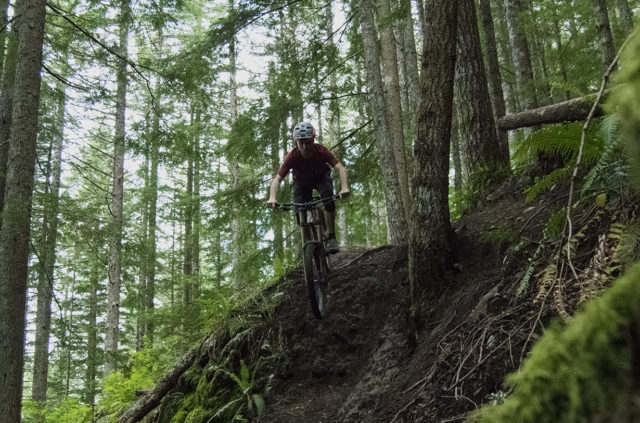
In this Mtn Biking 201 article, we’re going over the casing and rubber compound options from several of the major players in the MTB tire market. We’ll detail each brand’s most common casing and compound options, and discuss how they compare to other options from the other brands, based on our time testing them back to back.
Then, in this complementary guide, we offer some direct comparisons between many of the most popular mountain bike tire / tread options, and provide guidance as to which tires will best suit certain types of riders and riding conditions.
Both of these articles will be evolving documents that grow as we get time on more tires, and new designs are brought to market. So while we are by no means covering every brand, option, and variation right now, we are continually updating them with more info in the future in order to make them as useful as possible for most mountain bikers out there.
Finally, if you’re looking for more general advice on what to look for when you’re in the market for a whole new bike, you should check out our Mountain Bike Buyer’s Guide.
With that out of the way, let’s dive in:
Rubber Compounds
One of the most important, yet often overlooked aspects of tire selection is the rubber compound (or compounds) a given tire uses throughout its tread. While the tread pattern of a tire is what most people notice, how that tread pattern performs in various conditions will depend on what rubber compound is used.
Broadly speaking, softer rubber compounds will offer more grip, but do so at the expense of long-term durability and increased rolling resistance (i.e., they roll more slowly). Softer-rubber tires also tend to be fractionally heavier than those made with harder rubbers. The opposite of all this is generally true of harder rubber compounds.
Differences in grip between rubber compounds will become more pronounced on harder surfaces, and especially on surfaces that are hard and damp, such as wet roots and rocks.
Tall tire knobs made of soft rubber can also feel “squirmy” and vague on firm surfaces, due to the soft rubber’s inability to hold its form and support the rider’s weight without folding over. Many manufacturers (such as Maxxis, with their “3C” rubber compounds) attempt to mitigate this by constructing tires with a firmer rubber for the base that’s covered with a softer rubber cap. The goal is to produce knobs that have a firmer, more supportive structure, but that still put a sticky, soft rubber in contact with the ground (companies often refer to this sort of general construction as multi-compound, triple-compound, dual-compound, etc.). It’s also common for manufacturers to use harder rubber on the center knobs to create less rolling resistance and then softer rubber on the side knobs for better cornering grip.
Another performance benefit of softer-rubber tires is that they tend to rebound a bit more slowly when compressed, which helps the tires feel better damped / less prone to bouncing off the terrain, and consequently better maintain grip when slamming into roots, rocks, and the like. This is generally not a night and day difference, but can be felt, — especially in cases like high-speed, chattery, rooty sections, and it can also further help maintain grip in certain situations.
Since mountain bikes tend to bias the rider’s weight significantly over the rear wheel, rear tires have a greater impact on overall rolling resistance, and also tend to wear much faster. Some amount of rear-wheel slip also tends to be more acceptable when cornering and on off-camber sections, whereas most people really don’t want their front tire to slide out on them. For these reasons, it’s pretty common to run a softer rubber compound on the front tire and a firmer one in the rear to balance these traits. For the same reasons, running a slightly narrower rear tire is a fairly common choice as well.
Casings
A tire’s casing is the main body and structure of the tire and is generally constructed of one or more layers (referred to as “plies,” and often described with a thread per inch, or “tpi,” count) of a woven cloth material that are covered in rubber to hold it all together, seal in air, and offer some abrasion resistance.
Certain casing constructions include other elements, such as soft plastic or hard rubber inserts, generally placed near the bead (the more rigid part of the tire that interfaces with the rim to keep the tire on your wheel) to help reinforce the tire.
[Again, for more on the basics of tire construction, check out our Mountain Bike Tires 101 article.]
Many tire models come in a number of different casing options, but these tend to be a bit easier to understand than rubber compounds — heavier casings are generally tougher and more resistant to punctures and cuts, at the expense of, well, weight. Heavier, tougher casings can also provide a bit more sidewall support during hard corners as well as protection against “burping” tires (loss of air by temporarily breaking the tire’s bead seat against the rim when running a tubeless setup).
Comparing weights of tires can serve as a reasonably accurate, but not perfect, proxy for judging casing toughness (of course, you need to keep in mind variations in tire width and diameter, as well as knob size and density when comparing tire weights). That last point is particularly noteworthy with “Plus Size” tires, since a bigger-volume tire constructed of the exact same materials is going to weigh more. “Plus” tires are often labeled as having the same type of casings as their conventionally sized counterparts, but the Plus versions are often actually built lighter to keep the weight down vs. narrower options. To keep using the Maxxis DHF as an example, Maxxis’s published weight for the 27.5”, 2.5” wide, Exo casing, MaxxTerra rubber version is actually 20 g heavier than the supposedly identical spec in a 2.6” width. The wider tire isn’t magic — its casing is indeed thinner.
Rubber Compounds & Casings: Options from Popular Manufacturers
The following section will cover the rubber compound and casing options offered by the brands included in this guide, and describe their relative properties. It’s worth noting that, in some cases, we might not touch on every possible rubber compound or casing offered by a brand, but instead will focus on the ones offered for the Trail, Enduro, and DH tires that we’ve been reviewing. Rubber compounds will be ordered from hardest to softest, and casings from lightest to burliest.
And, as we noted above, we’ll be updating this post with info on more brands in the future.
Maxxis
Maxxis is based in Taiwan and is one of the longest-standing and best-established players in the mountain bike tire space. Their Minion DHF tread pattern has been around for going on two decades now (!!!), but it remains one of the best, most popular, and most versatile tires out there. Over the years, their lineup has expanded enormously, both in terms of the number of tread patterns and specific configurations of those patterns. They remain the biggest and most prevalent manufacturer of mountain bike tires out there, in addition to making tires for a wide range of other vehicles, including cars and trucks.
Maxxis Rubber Compounds
Maxxis has, annoyingly, stopped publishing durometer (quantitative measurement of hardness) specs for their rubber compounds in recent years. They do still describe the construction in more qualitative terms, and fortunately, we’ve spent a lot of time using most of their different rubber compounds. The breakdown of their rubber-compound offerings goes as follows:
Single
This is Maxxis’s most basic and hardest rubber compound, and is only offered in limited versions for the tires covered in our guide. As the name implies, it’s a single-compound rubber across the full width of the tire, and is quite hard and wear resistant, but less grippy than their softer-rubber offerings.
Dual
Dual is Maxxis’s first step-up in softness from their Single compound, and is the hardest available rubber-compound option for most of their more aggressive tread patterns. As the name would suggest, Dual is actually two different rubber formulations — a firmer one in the center tread for durability and less rolling resistance, and a slightly softer one for the side knobs. Dual compound tires are notably softer than Single ones, especially on the side knobs, but are still on the firm, hard-wearing end of the spectrum compared to the whole market.
3C MaxxTerra
Maxxis has long offered a “3C” (i.e., triple compound) rubber option, which features a harder-rubber base to stiffen the knobs and reduce deflection, with a medium-stiff rubber over the center knobs, and a softer rubber over the side knobs for increased grip. More recently, the 3C offerings grew to 3C MaxxSpeed (reserved for XC-oriented tires, so not applicable to any tires in our guide), 3C MaxxTerra, and 3C MaxxGrip.
All three use the same concept, but vary in terms of overall firmness — as one would expect, MaxxSpeed is overall the firmest, fastest-rolling rubber of the three, MaxxGrip is the softest, and MaxxTerra falls in the middle.
3C MaxxTerra is the most common rubber compound used in Maxxis’s higher-end Trail and Enduro tires, and is notably softer and stickier than their Dual compound offerings.
3C MaxxGrip
As mentioned above, MaxxGrip is the stickiest of the 3C offerings from Maxxis and feels very similar to the 3C Maxxis tires of old, before the introduction of the multiple “Maxx____” variants of 3C formulation.
3C MaxxGrip is available predominantly in dual-ply, Downhill-casing constructions (more on that in a bit) but can also be found in select Trail / Enduro constructions. Compared to MaxxTerra, MaxxGrip is significantly … grippier, wears a bit faster, and creates marginally more rolling resistance.
SuperTacky
Unlike most other offerings from Maxxis, SuperTacky is a single-compound construction, and as the name would suggest, it’s quite soft.
In most tread patterns, the SuperTacky compound is only offered with Downhill casings. Compared to 3C MaxxGrip, SuperTacky wears a little faster and grips slightly better on things like wet roots, but can feel a little squirmier on really hard surfaces, such as hardpacked bike-park trails.
Maxxis Casings
Exo
Exo is Maxxis’s catch-all for a light, Trail-bike-oriented casing. The Exo casing essentially takes a standard single-ply casing and adds a woven material at the sidewall for protection against sidewall cuts and general abrasion.
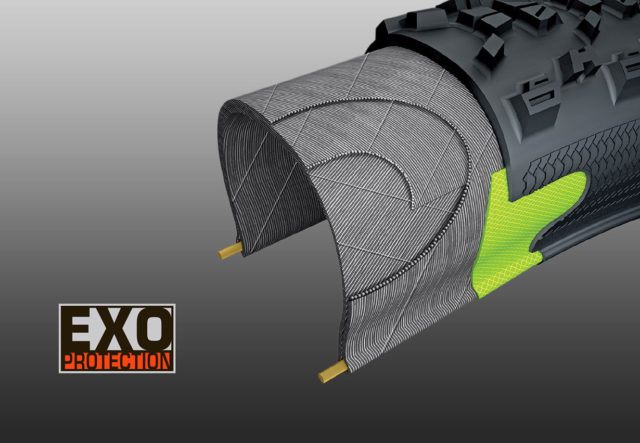
As noted in the intro, not all Exo casings are created exactly equal — Maxxis’s Plus-size tires (2.6” and wider), in particular, tend to feature a lighter construction than their more traditionally sized, narrower counterparts.
Most of Maxxis’s Exo offerings are also designated as Tubeless Ready (“TR” will be listed on the sidewall for these), but a few tires, especially in older 26” size versions, aren’t specifically designated as such. These non-TR versions can still be set up tubeless, but can be more prone to leaks and blowing the bead off the rim under hard cornering.
Exo+
Exo+ is a newer offering from Maxxis and is meant to be similar to their popular Exo construction, but with a bit of added puncture resistance due to an added layer of “Silkshield” material — basically an extra, full-width layer of a material that’s a bit lighter than a full, standard casing ply.
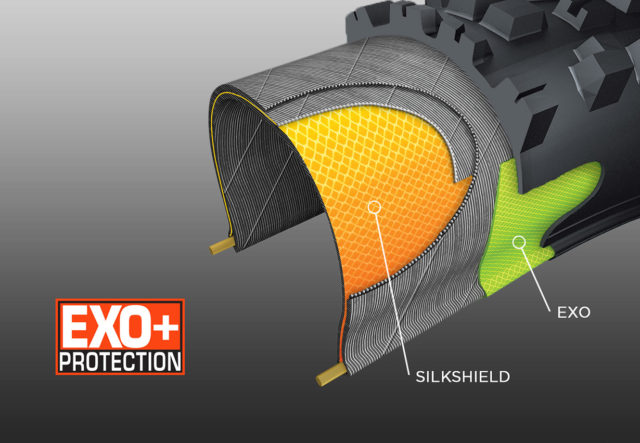
The ride feel of Exo+ is very similar to standard Exo tires, but the Exo+ construction does seem to be somewhat more cut resistant, especially in the center of the tread. Maxxis claims a weight increase of roughly 50 g per tire for Exo+ over Exo, but in our experience, the actual difference is closer to 100 g, when comparing otherwise similar tires.
DoubleDown
DoubleDown (or “DD”) is Maxxis’s second-burliest casing, designed for Enduro use. Compared to Exo, the DD casing uses two plies of casing layers, each with 120 threads per inch (Exo is 60 tpi and single-ply). The DD casing also adds a rubber insert over the bead to protect against pinch flats and improve sidewall cut resistance.
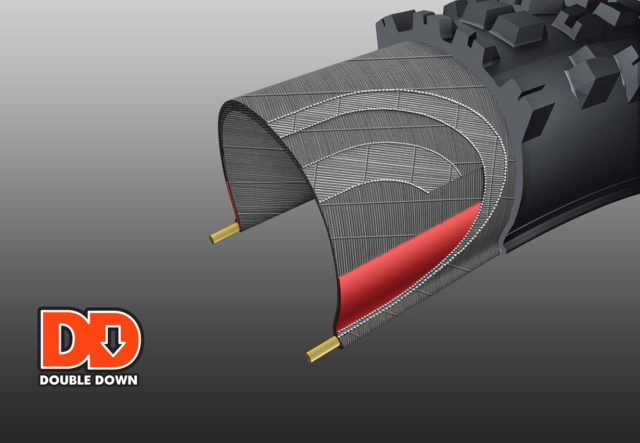
Compared to Exo, going up to the DD casing adds about 200 g per tire and does provide a very appreciable bump-up in durability and sidewall support. DD casings are all designated as being Tubeless Ready.
Downhill
Finally, Maxxis offers dual-ply “Downhill casing” tires, mostly with wire beads (whereas most of their other casing options come with folding Kevlar beads). The wire-bead, Downhill-casing tires are roughly 200 g heavier per tire than their DoubleDown counterparts, while the Downhill-casing options with folding Kevlar beads gain about ~100 g per tire vs DD casings.
Maxxis’s Downhill-casing tires are another substantial step-up over Double Down casings in terms of cut resistance and durability, though the jump is somewhat less pronounced than that between Exo+ and Double Down. Maxxis’s Downhill-casing tires work well tubeless, despite mostly lacking an official “TR” designation.
Schwalbe
Schwalbe is a German company that was founded in 1922 and that, until recently, exclusively made tires for bikes (they now also make tires for wheelchairs). The Magic Mary is their most iconic, widest-used MTB tire for aggressive riding, and is frequently discussed as a competitor to the Maxxis Minion DHF and Maxxis Minion DHR II.
Schwalbe Rubber Compounds
Schwalbe doesn’t publish a lot of specific information about their rubber compound offerings, such as durometers or even much detail on how many different rubber compounds go into a specific formulation and how they’re arranged. Their naming is straightforward though, indicating the relative firmness of the various options.
Addix Speedgrip
Addix Speedgrip is the firmest rubber compound offered on most of Schwalbe’s aggressive mountain bike tires, and only comes in very select casing and size options for these tires. It’s intended to be a competitor to Maxxis’s 3C MaxxSpeed, and it does indeed roll quite well, while maintaining respectable grip and decent durability. It’s not as hard wearing as some very-firm options, such as Maxxis’ Dual compound, but also feels notably tackier and grippier, especially on very hard surfaces.
Addix Soft
Addix Soft is the most common compound used in most of Schwalbe’s Trail- and Enduro-oriented tires. Neither brand publishes enough data to quantifiably compare the two, but in our experience, Schwalbe’s Addix Soft feels similar to, or perhaps slightly firmer than Maxxis’s popular 3C MaxxTerra rubber.
Addix Ultra Soft
Addix Ultra Soft is, unsurprisingly, Schwalbe’s softest rubber formulation, and is generally paired with heavier-duty casings and more aggressive tread patterns. Addix Ultra Soft is quite soft and grippy, and wears fairly quickly.
It’s a bit difficult to compare the exact differences between rubber compounds across different brands’ different tread patterns. But in general, Addix Ultra Soft is similar to, or slightly softer than Maxxis’s 3C MaxxGrip in terms of durometer and wears slightly faster. Addix Ultra Soft tires are also notable for their particularly slow rebound and very damped feel.
Schwalbe Casings
SnakeSkin
[Note: As of 2021, Snakeskin is being phased out in Schwalbe’s line for many of their MTB tires.]
SnakeSkin is Schwalbe’s general-purpose, Trail-bike casing. When comparing similarly aggressive tires, it tends to be a little bit lighter and correspondingly slightly less burly than the Maxxis Exo casing, particularly in resistance to cuts down the center of the tread.
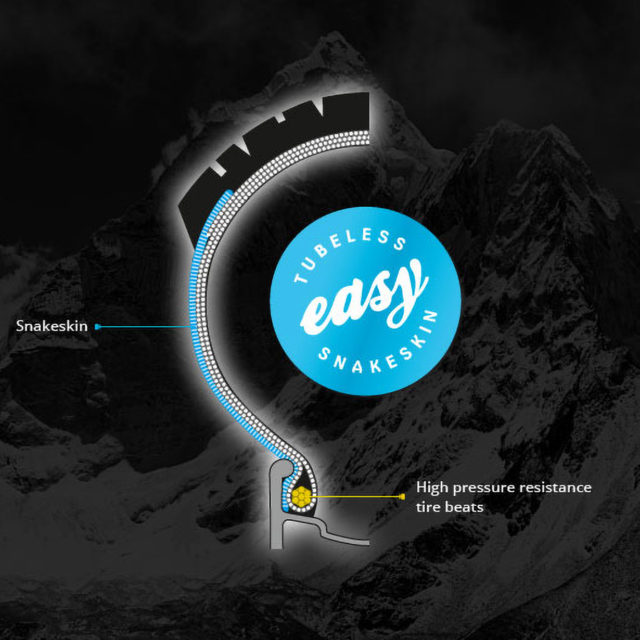
Super Trail
Super Trail is a new construction from Schwalbe, meant to replace their prior “SnakeSkin with APEX” offering, for all-around Trail bike use. An in-between casing has long been on the wish list of a lot of Schwalbe fans — the jump in both weight and toughness from the old SnakeSkin tires to Super Gravity ones was huge, and something in between could be a good “Goldilocks” option for a lot of people.
Schwalbe says that Super Trail tires are about 100 g lighter than their Super Gravity counterparts on average, but from the samples we’ve tested, the difference is much smaller — closer to 20 g. Where the new Super Trail casing does differentiate itself more is in terms of ride feel. Despite not being substantially lighter, it is significantly more supple, and gives a smoother ride, especially when being run at very low pressures. Conversely, Super Gravity tires have notably better sidewall support.
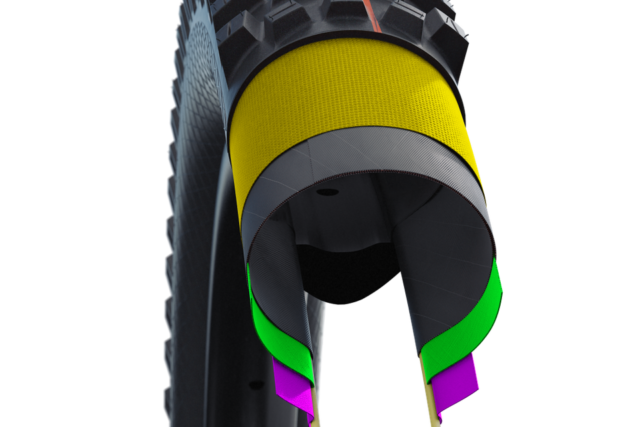
Overall durability of the new construction has been good — it seems to be close to on par with Maxxis’ Double Down — but riders hoping for a lighter Trail bike casing than Super Gravity might be a bit disappointed by the weight.
Super Gravity
Super Gravity is Schwalbe’s heavier-duty, Enduro-oriented casing. It’s close to Maxxis’s Double Down casing in terms of weight and durability; if anything, Super Gravity is a bit tougher and heavier. Schwalbe left the Super Gravity casing unchanged in their latest round of updates.
Compared to Super Trail, Super Gravity features additional plies of material through the entire casing, as well as further reinforcement at the bead. Unlike Double Down, the Super Gravity casing’s bead reinforcement comes in the form of an additional fabric layer in the casing, rather than a rubber insert.
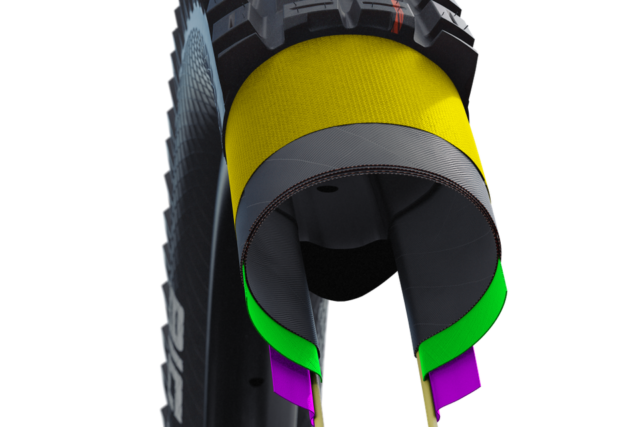
Though Super Gravity tires have an additional ply, compared to their Super Trail counterparts, and feel notably stiffer / less supple, our measured weights for otherwise identical tires in the two different constructions are surprisingly similar. All Super Gravity tires are designated as being tubeless compatible.
Super Downhill
Schwalbe’s Downhill casing construction adds about 100 g per tire over Super Gravity tires, and cuts a bit of weight compared to the prior Downhill casing by going to a folding Kevlar bead. We haven’t yet spent time on the new construction, but Schwalbe says the change to a folding bead is the only significant update compared to the prior Downhill casing. Given that, and our experience with the older wire bead Downhill casing, Super Downhill should be quite similar in both weight and durability to Maxxis’ newer Downhill casing tires with a folding bead.
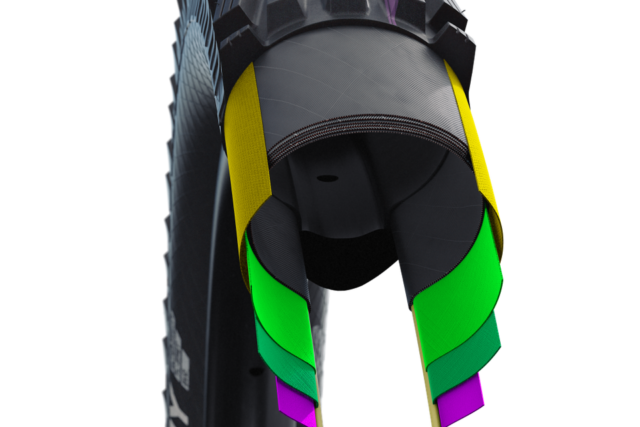
Most of Schwalbe’s Super Downhill-casing tires only come in Addix Ultra Soft rubber, and are all tubeless compatible.
e*thirteen
e*thirteen has been making a variety of mountain bike components for several decades, but is a relative newcomer to the tire game and currently offers a relatively modest range of tires, all intended for aggressive mountain bike use.
e*thirteen Rubber Compounds
e*thirteen offers three rubber formulations for their tires; Plus, Race, and MoPo. All three are some variant of a multi-compound construction, with a firmer base rubber covered in a softer top layer.
Plus
Plus is e*thirteen’s firmest, hardest-wearing, and fastest-rolling rubber compound. e*thirteen describes it as having a medium-soft top layer over their hardest base rubber. This is a bit different than Maxxis’s Dual compound construction, which uses one rubber for the center knobs and a softer one for the side knobs, but the overall performance characteristics of the two feel fairly comparable.
Race
Race is e*thirteen’s medium-soft rubber compound, which they describe as having soft side knobs that are paired with a medium-soft rubber for the center knobs and base. The Race rubber compound continues to parallel Maxxis’s offerings fairly well, feeling roughly on par with Maxxis’s 3C MaxxTerra construction.
MoPo
MoPo — short for “Motion Potion” — is e*thirteen’s stickiest rubber option. They claim (unclear if it’s tongue in cheek or not) that it’s derived from Thailand’s underground moped drag-racing scene.
The MoPo construction is a bit different than the sticky offerings from other brands — e*thirteen describes it as featuring an ultra-soft tread over a medium-soft base, but the result is that the knobs feel surprisingly firm overall. The very top layer of rubber is quite tacky, to be sure, but our hunch is that it’s a relatively thin layer, and that the firmer base material comprises the majority of the knob volume. The result is excellently supported knobs that don’t feel as squirmy on very hard surfaces as the softer-rubber offerings from the likes of Maxxis or Schwalbe, but still do have a legitimately sticky top coat.
The tradeoff here is that MoPo’s firmer knobs do deform less readily on certain uneven surfaces. This somewhat mitigates the benefits of the stickier rubber, particularly on things like exposed roots and rocks, but it’s a good tradeoff for relatively dry conditions — where e*thirteen’s available tread patterns also happen to excel — but perhaps makes a bit less sense when conditions get really wet and slippery.
e*thirteen Casings
As with their rubber compounds, e*thirteen offers three casing options in their tires — TRS, LG1 EN, and LG1+ DH — ranging from a relatively lightweight Trail casing through a full dual-ply, DH-oriented option. All of e*thirteen’s current casing options are tubeless compatible.
TRS
e*thirteen calls their lightest-weight construction “TRS” and states that it’s a 72 tpi, single-ply casing.
It’s worth noting that e*thirteen’s casing / rubber compound combos are a bit more complex. Their Race and MoPo rubber options include an Aramid reinforcement that e*thirteen says increases puncture protection (the basic Plus version makes do without the Aramid reinforcement). In terms of weight and durability, the TRS-casing tires in the Race and MoPo compounds (which include the Aramid reinforcement) seem to be roughly on par with Maxxis’s Exo+ construction.
LG1 EN
Things get a little more complicated with e*thirteen’s mid-weight casing, the LG1 EN, since it differs a bit based on tread pattern.
The e*thirteen AT Gen 3 tire with the LG1 EN casing features a two-ply construction (72 tpi for the Plus-compound tires; 120 tpi with Aramid reinforcement for the Race-compound and MoPo-compound versions). But an e*thirteen Semi-Slick tire in the LG1 EN casing is a 72 tpi single-ply, albeit a thicker and tougher one than is found in the TRS casing.
So far, we’ve only tested the LG1 EN casing in the AT Gen 3 tread pattern with both the Race and MoPo compounds (which, as stated above, is a two-ply construction with 120 tpi and an Aramid reinforcement). This version of the LG1 EN casing falls somewhere between Maxxis’s Exo+ and DoubleDown casings in terms of weight, and seems to be impressively tough for its weight, though it is a little less supple than Double Down or Schwalbe’s Super Gravity casing.
LG1+ DH
We haven’t yet spent time using a tire with the LG1+ DH casing, but e*thirteen describes it as a dual-ply, 120 tpi construction with a folding bead. On paper, it sounds like it should be roughly comparable to the folding-bead version of Maxxis’s Downhill casing, but we’ll need to test a set to know for sure, and will update this if and when we do.
WTB (Wilderness Trail Bikes)
Wilderness Trail Bikes, now mostly known as WTB, is one of the first dedicated mountain-bike brands, having been founded in California in 1982. Later, WTB went on to play a significant role in pioneering 29” wheels for mountain bikes. Though they’re no longer producing frames, WTB is still a major player in the markets for saddles, tires, rims, and various bike accessories.
WTB Rubber Compounds
WTB’s rubber compound names are refreshingly straightforward, and their options are simple: Fast Rolling and High Grip.
Fast Rolling
WTB refers to their harder rubber offering as Fast Rolling across their range of tires, but the rubber compounds that go by that name vary somewhat, depending on which casing they’re paired with.
The Light-casing versions of the Fast Rolling compound are a dual-compound formulation, with what WTB describes as medium-soft rubber on the side knobs and hard rubber in the center.
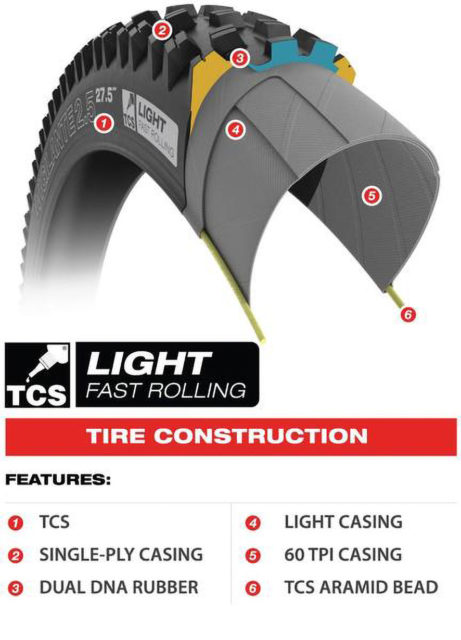
The Tough-casing version of the Fast Rolling compound gets a triple-compound construction, with a hard-rubber base, medium-soft rubber on the top of the center knobs, and a soft-rubber layer atop the side knobs. In the Tough casing, triple-compound version, the Fast Rolling rubber feels quite similar to Maxxis’s 3C MaxxTerra formulation.
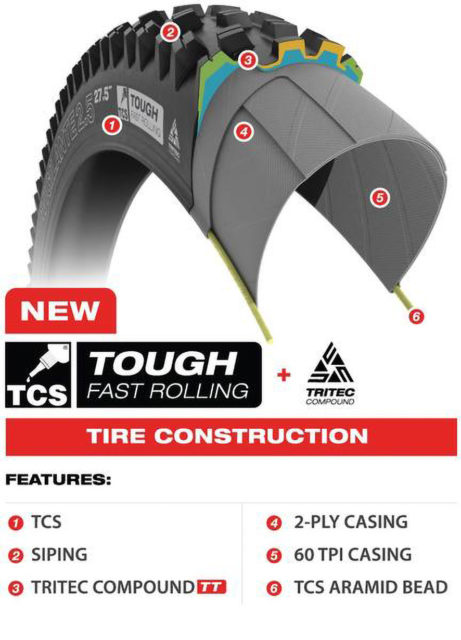
High Grip
This is, as I’m sure you’ve guessed, WTB’s stickier, grippier rubber option. Unlike the Fast Rolling formulation, the High Grip rubber is a triple-compound construction on both casing options, with hard rubber on the base, soft rubber on the center knobs, and extra-soft rubber on the side knobs.
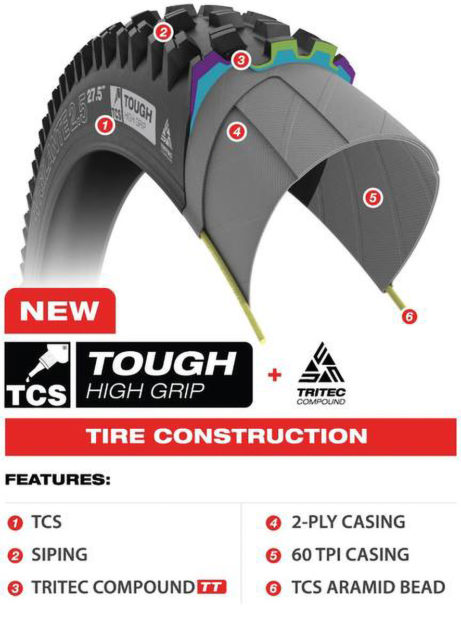
This formulation is noticeably softer than the Fast Rolling version, but not as soft as Maxxis’ 3C MaxxGrip or Schwalbe’s Addix Ultra Soft. WTB’s High Grip rubber feels softer overall than e*thirteen’s MoPo rubber, apart from the very top layer of the e*thirteen MoPo compound.
WTB Casings
As with their rubber compounds, WTB offers two casing options with a very straightforward naming convention: TCS Light and TCS Tough. Both are tubeless compatible.
TCS Light
WTB’s TCS Light casing is a 60 tpi, single-ply casing paired with a folding bead, though versions paired with the High Grip rubber compound also add a nylon insert in the sidewall, meant to improve cut resistance.
Though it’s described as light — as opposed to tough — the TCS Light construction is still a fairly robust, not terribly light construction; I’d place it somewhere between Maxxis’s Exo+ and Double Down construction.
TCS Tough
TCS Tough is WTB’s burlier, dual-ply option, adding a second 60 tpi casing ply to the TCS Light offering. As such, it’s on the heavier, burlier side of the spectrum; Schwalbe’s Super Gravity casing feels like the closest comparison in terms of toughness and weight. Compared to Maxxis’s offerings, TCS Tough falls somewhere between the Double Down and Downhill casings.
Michelin
Michelin is a French brand that has been manufacturing pneumatic bike tires since the late 1800s, and are credited with inventing the clincher tire and tube arrangement that remains the standard configuration for bike tires to this day. Michelin’s mountain bike tires were a popular option for downhill riders particularly in the 2000s — most notably their DH24 and DH32 — but they were slow to catch up to the rising prominence of Enduro riding in the 2010s and faded from popularity for a bit. They’ve since revamped their lineup, brought out a bunch of new Enduro and DH models, and we’ve been spending time on several of their latest offerings, which you can read more about in our Tire Comparisons article.
Michelin Rubber Compounds
Michelin doesn’t subscribe to the more-is-more philosophy certain other brands (especially Maxxis) run with when it comes to options for rubber compounds and casings. Most of Michelin’s tire models are available in only a single rubber compound, with a few tires offering a second option. Broadly speaking, their firmer rubber options are branded “Gum-X,” whereas the softer ones go under the “Magi-X” moniker (does anybody else think that sounds backward?) but there are finer distinctions made under those two umbrellas that we’ll describe more below.
Gum-X
Gum-X is Michelin’s more basic, harder rubber compound offering, and it feels a touch softer than Maxxis’s Dual compound. Michelin doesn’t offer a lot of information on how it’s formulated, but Gum-X tires are on the firmer, longer-wearing end of the spectrum.
Gum-X3D
Michelin also offers a triple-compound variant of their Gum-X rubber formulation, referred to as Gum-X3D. While the regular Gum-X is significantly firmer than Gum-X3D, Gum-X3D is still overall firmer than Maxxis’s 3C MaxxTerra or Schwalbe’s Addix Soft compounds.
Magi-X2
Magi-X2 is the softer, dual-compound rubber formulation used in some of Michelin’s Enduro tires. While it’s softer than their Gum-X rubber formulations, I’d say Magi-X2 is only “medium-soft,” roughly on par with Maxxis 3C MaxxTerra.
Magi-X DH
Michelin’s DH tires get a different, slightly softer Magi-X variant than the Magi-X2 used for the Enduro tires. Michelin unfortunately doesn’t publish any specifics as to how the Magi-X DH is formulated, and while it’s softer than Magi-X2, it’s not exceptionally so. Magi-X DH feels like it falls between Maxxis’s 3C MaxxTerra and 3C MaxxGrip, or Schwalbe’s Addix Soft and Addix Ultra Soft. Despite not being the absolute softest, stickiest rubber out there, Magi-X DH does rebound notably slowly, which does contribute to a more muted, better damped feel than springier, faster-rebounding rubber formulations.
Michelin Casings
Most of Michelin’s current tires don’t come in multiple casing options; broadly speaking, their Enduro tires fall somewhere between Maxxis’s Exo and Double Down casings in terms of weight and toughness, and Michelin’s Downhill tires are exceptionally burly, even compared to other brands’ DH offerings. Since Michelin’s casing options tend to be largely tread-specific, we’ll be discussing them in more detail in the sections on each tire in our Comparisons article.
Versus
Versus is a newer brand on the tire scene, bringing a direct-to-consumer model to mountain bike tires. Their stated goal is to bring performance that’s competitive with the established brands, but at a lower price by cutting out the middlemen. So far, they’ve only got one model on the market, but it’s proven to be a good all-rounder.
Casings
The Versus All Mountain tire is available in two different casing options, simply named “Trail” and “Gravity”.
Trail Casing
Versus’ Trail casing is a single-ply, 60-TPI option with a folding bead. It’s a good, relatively lightweight option, similar in weight and toughness to Maxxis’ EXO offering. As one would expect for a modern tire offering, it’s tubeless compatible and sets up and holds air easily. The Versus Trail casing has held up well for its weight class (~1000-g per tire, in a 29 x 2.4’’ size) but as with other similarly light casings, is more susceptible to cuts and flats than more substantial, heavier options like Maxxis’ Double Down or Schwalbe’s SuperGravity.
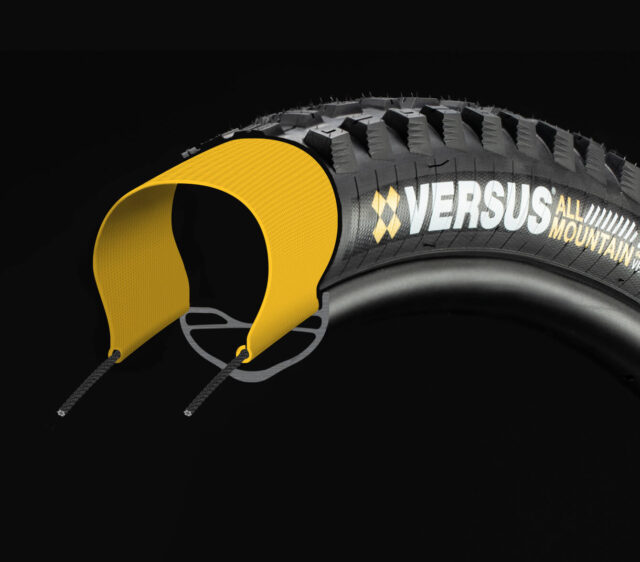
Gravity Casing
Versus also offers their tires in a dual-ply, wire-bead casing. We’ve yet to test this option, but it sounds broadly similar to many other brands’ downhill casings, including those from Maxxis and Schwalbe. At a stated weight of ~1500 g per tire in a 29 x 2.4’’ size, it should be a stout construction, but comes at a substantial weight penalty as compared to the Trail option.
Versus Rubber Compounds
Both of Versus’ constructions are dual-compound offerings, with firmer rubber on the center tread for rolling resistance and wear properties, and softer rubber on the corner knobs for grip. Unlike some other brands, Versus doesn’t offer mix and match combinations of casing and rubber compound — the Trail casing and Trail rubber compound are the lone pairing for those options, and the Gravity casing comes in their Grip compound only.
A unique option that Versus does offer is a colored splatter pattern in both the Trail and Grip rubber compounds. Versus says it adds a few grams over the basic black option, but otherwise performs the same. Plain black tires are also available for anyone who’d prefer a more subtle aesthetic.
Trail Compound
The Trail compound from Versus is a dual-compound option, with a stated 63 / 60 durometer. It’s a relatively firm, hard-wearing compound that feels largely similar to Maxxis’ Dual compound. Compared to stickier rubber compounds, it does give up some grip, especially on wet and/or hard surfaces, but it rolls well and lasts much longer than ultra-soft options.
Grip Compound
Versus’ Grip compound is the lone option for the Gravity casing tires, with a stated 58 / 52 durometer. We’ve not yet tested this version, but expect it to be about middle of the spectrum when it comes to trading off grip vs. rolling resistance and wear properties.
Specialized
These days, Specialized is best known as a bike brand, but they actually got their start making touring tires, and have long made mountain bike tires as well — one of the few frame manufacturers to do so. They make a full range of tires, from Cross Country- through Downhill-oriented options, with the Butcher being their longstanding model that’s intended in no small part to be a competitor to Maxxis’ Minion DHF.
Specialized Rubber Compounds
Specialized recently gave their rubber compounds a massive overhaul. In fact, they’ve gone so far as to open their own tire factory, in conjunction with IRC, in part to take control of their own rubber engineering, where they’d previously relied on their manufacturing partners for expertise. Past Specialized tires have sometimes struggled to get their rubber compounds dialed — Specialized even admitted that some of their gravity racers had been running other brands’ tires with the hot patch Sharpied over, in years past — and so a bit of a new approach was needed.
Gripton T7
Specialized has used the Gripton moniker before, but the T7 part is new, and the rubber formulation is entirely different from prior iterations. In short, Gripton T7 is meant to be a good all-rounder, balancing grip, rolling resistance, and wear properties, somewhat akin to Maxxis’ 3C MaxxTerra or Schwalbe’s Addix Soft. We haven’t yet tested the T7 formulation but hope to soon, and will update if and when we do.
Gripton T9
Gripton T9 is Specialized’s softest, grippiest rubber offering, but longtime users of Maxxis’ 3C MaxxGrip or Schwalbe’s Addix Ultra Soft might be surprised that it doesn’t feel that soft, when squeezing a knob. Specialized’s argument is that what matters most for making a high-performance, gravity-oriented rubber compound isn’t so much out-and-out softness, but having rubber that rebounds very slowly, and that’s what they’ve targeted with Gripton T9. The idea is that a slow-rebounding rubber sticks to roots and rocks in large part because it simply doesn’t bounce off them in the way that a faster-rebounding rubber does. Going softer with the rubber compound is often an effective way to achieve slower rebound, but isn’t necessarily desirable in and of itself. Very soft rubber compounds can feel squirmy and vague when being pushed hard on firm surfaces, so Specialized might have a point here.
The Gripton T9 Butchers that we’ve been testing do feel like they blend the best traits of medium and very soft rubber compounds, to some extent. The T9 rubber is much harder wearing and faster rolling than 3C MaxxGrip or Addix Ultra Soft, but still offers very good grip on wet roots and rocks and the like. It doesn’t feel quite as grippy as those very stickiest rubber options on the market, but is also less squirmy and vague on harder surfaces, and as such does feel like a really good blend of traits that will work well for a lot of people.
Specialized Casings
With the change in factory, Specialized overhauled their casing options, too. The two options for their more aggressive tires are the all-new Grid Trail and Grid Gravity.
Grid Trail
Specialized’s Grid Trail casing is a construction meant for Trail and Enduro bike use, and comes in at a similar weight to the Maxxis Exo casings. The most notable trait of the Grid Trail construction is just how supple it is. The ride quality is really notably better than many of its competitors, including Maxxis Exo. Especially for riders who like to run very low pressures to seek the most compliant ride, it’s a really good option.
The Grid Trail casing is also especially easy to get to seal tubeless — I’ve mounted them on a handful of different wheels, and despite not having a particularly tight bead, they do an unusually good job of sealing on the rim before being fully seated, which makes it far easier to get them to seat with a floor pump. Durability of the Grid Trail also seems quite respectable for its weight, but no tire in the ~1000 g range is going to be as tough as its much heavier counterparts, which is where the Grid Gravity construction comes in.
Grid Gravity
We have yet to get our hands on a set of the Grid Gravity tires, but it’s the burlier casing option for the new Specialized tires, and they say that it’s similar to the downhill-construction options from other brands. We’ll update the guide with more particulars if and when we’re able to get time on the Grid Gravity casing.
Hutchinson
Hutchinson has been making bike tires for more than 130 years, in France, and they say that they’re the only company to still do so. They make a wide range of bike tires, for both road and mountain bikes, but we’ll be focusing on their more aggressive mountain bike offerings here.
Hutchinson Rubber Compounds
Hutchinson’s more aggressive tires come in two different rubber formulations: Bi-Compound, and a triple-compound version that they call Race Ripost Gravity.
Bi-Compound
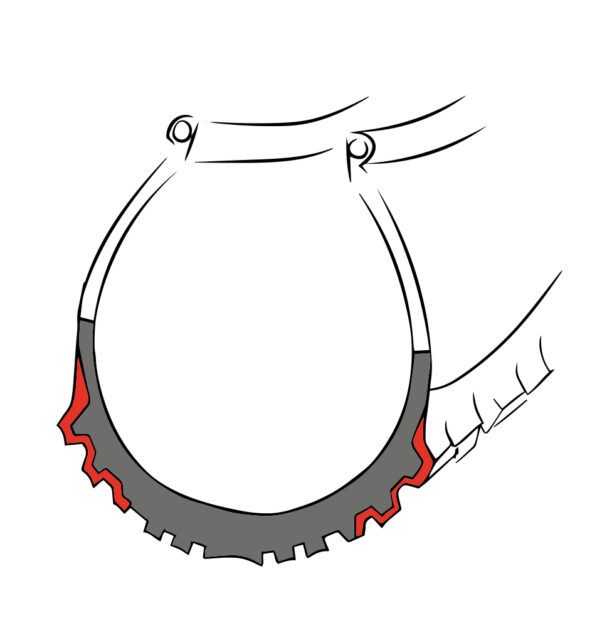
Hutchinson’s more basic rubber formulation for their gravity-oriented tires is simply referred to as Bi-Compound, and consists of a 60a durometer base rubber, with a softer 50a cap over the side knobs. We’ve yet to test this particular rubber compound, but on paper, it sounds very similar to the Maxxis Dual rubber formulation.
Race Ripost Gravity
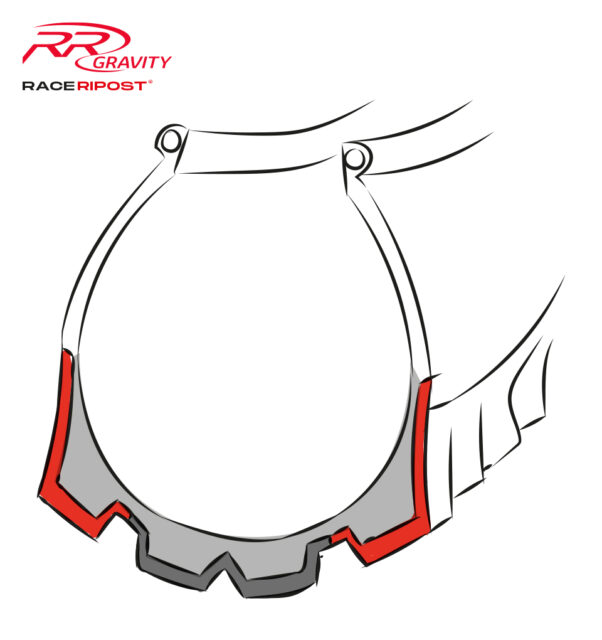
Hutchinson’s Race Ripost Gravity is a three compound formulation found in their higher-end, gravity-oriented tires. In short, it uses a quite firm 65a base layer, with 50a caps on the center knobs, and very soft 39a ones on the side knobs. Though the top rubber on the side knobs, in particular, is quite soft, the resulting knobs feel fairly firm and well supported overall.
All of this adds up to a rubber formulation that rolls quite well and has better than average durability, while still offering a whole lot of cornering grip. The firm center knobs aren’t as confidence inspiring on wet roots, in particular, as some softer compounds like Maxxis’ 3C MaxxGrip or Schwalbe’s Addix Ultra Soft, but it’s an excellent design for tires that are going to be used primarily in drier conditions.
Hutchinson Casings
Hutchinson’s more aggressive tires are offered in two different casing options — a single-ply, 66 TPI option, and a burlier dual-ply version, with two 66 TPI layers. Hutchinson doesn’t have flashy names for the casing options, simply referring to them as “66 TPI” and “2x 66 TPI”
66 TPI
Hutchinson’s 66 TPI casing is the lighter-duty version, meant for use on Trail bikes. We haven’t been able to get our hands on that construction yet, but its stated weights put it roughly in line with Maxxis’ Exo+ or Michelin’s Enduro tires. We’ll update if and when we’re able to get on this casing.
2X 66 TPI
Hutchinson refers to their burlier 2X 66 TPI casing as being a Downhill option, but in terms of weight and feel, it’s a bit closer to Maxxis’ DoubleDown or Schwalbe’s Super Gravity. It’s a stout casing with good puncture resistance, but also is very notably supple for a casing in this weight class — it rides far more smoothly than Double Down, and a bit more so than Super Gravity. Despite that suppleness, sidewall support is still fairly good — it’s a very impressive offering.
The 2X 66 TPI casing is tubeless compatible, but it does take a little more time and effort to get the tire to fully seal than with some other tires. Getting the bead to seat hasn’t been particularly troublesome, but the casing seems to be a touch more porous and takes some extra care to get sealant distributed fully so that it doesn’t slightly leak. Once it’s set up though, we’ve had no issues and see this as a minor annoyance at worst.

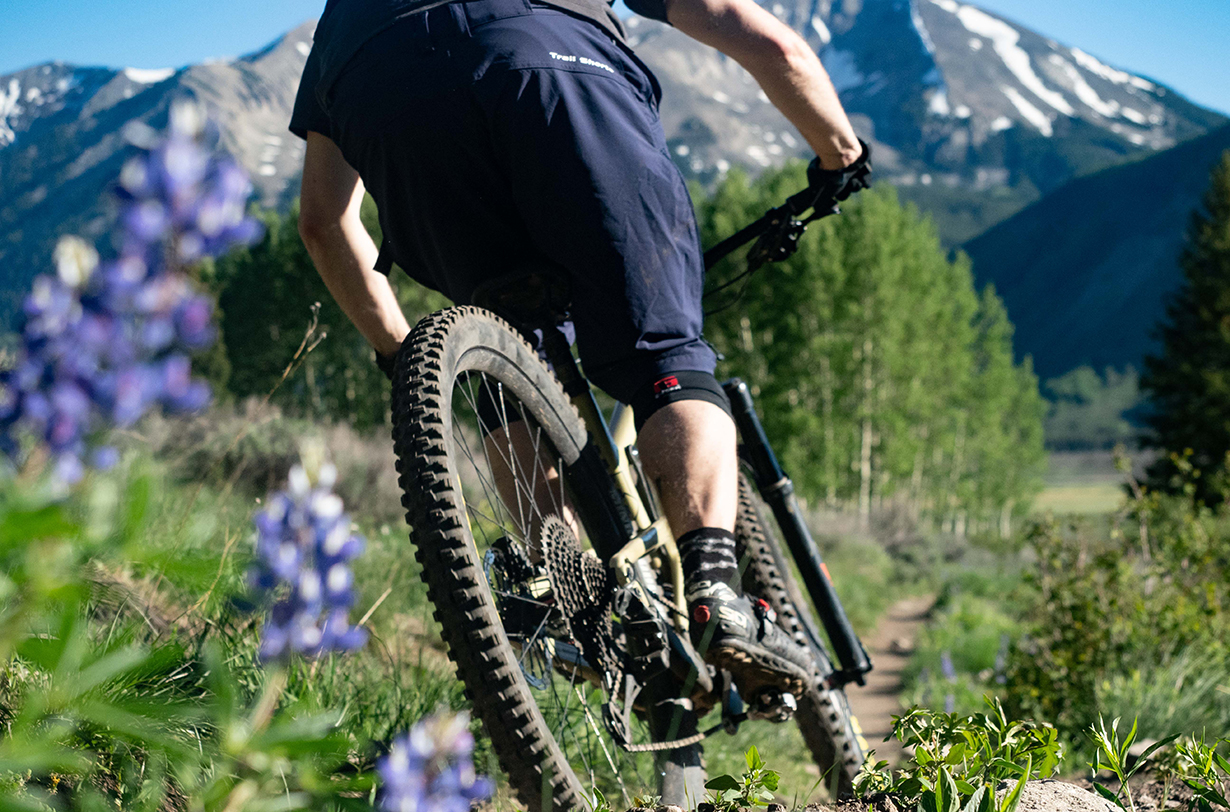
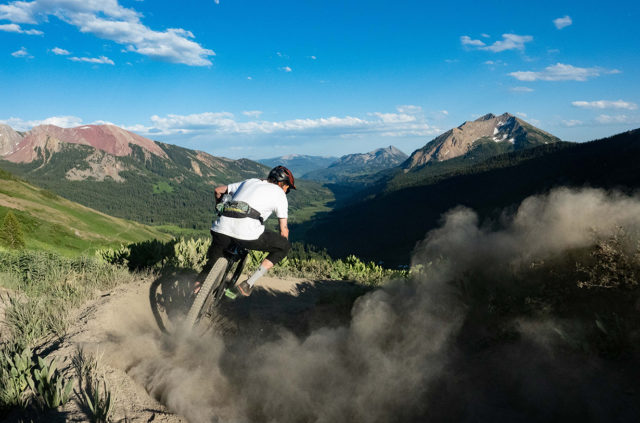
Schwalbe just overhauled their tires casings. Mostly it’s just a name change, but there are some differences too.
Yeah, we’re working on getting some of their new stuff to test. We’ll update this once we’ve been able to check it out.
“that basic moniker isn’t nearly adequate to describe any given tire”
Why do manufacturer’s do this? Why is this article necessary? Same question applies for the excellent brand guides Blister produces for shoes.
On topic: Where is Conti?
Thanks for the article btw, very informative!
Thanks for all the information!
A quick thought: It would be easier to digest if it were in a comparison table where the “quality” (e.g. durability, wear rate, grip, etc.) was listed in vertical columns from X to Y, the manufacturer in horizontal rows, and the individual compounds slotting into their respective spot on the grid.